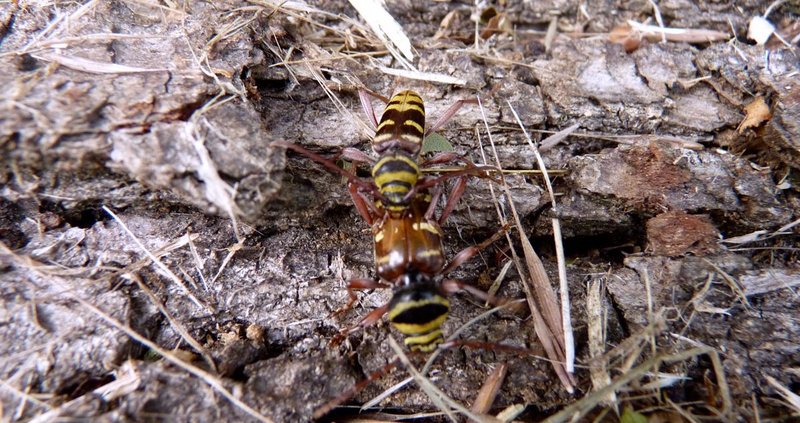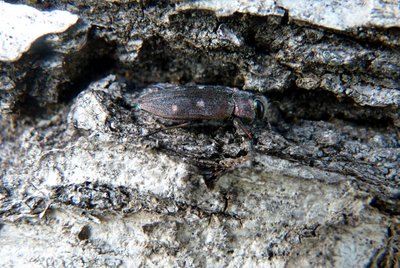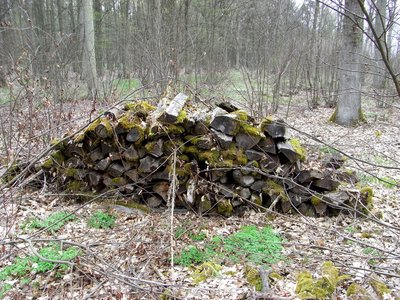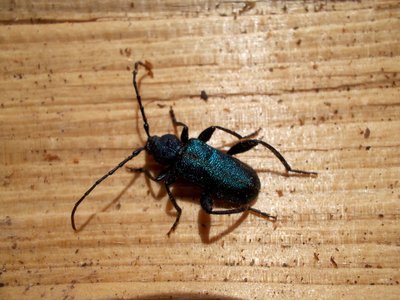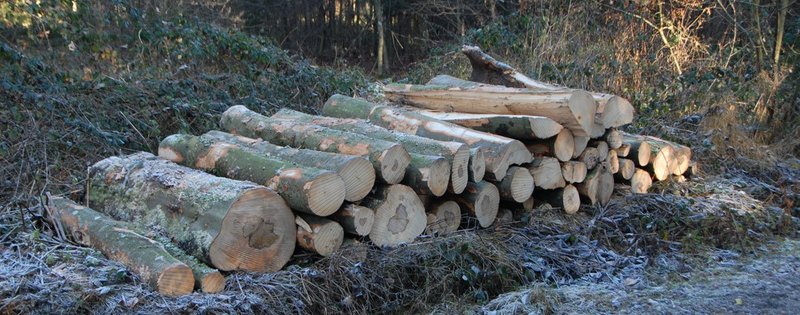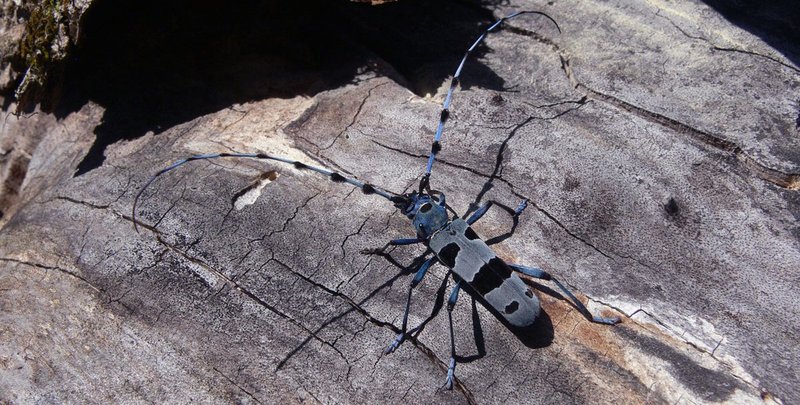Dead wood - vital for many species
Every grade of timber has its "lovers", and that is the case from the very first minute - from the moment of felling right through to almost complete decomposition. If the timber is left lying in the forest over longer periods, representatives of these "timber-lovers" are drawn as if by magic to the wood and try to colonise it or use it as a hiding place. Among beetles alone, there are some 3.500 species dependent on dead trees, and around two thirds of these are considered to be endangered. Many fresh deadwood-colonisers are not only endangered by the shortage of their particular resource, but in fact mainly because of other factors:
- Many species also need an abundance of flowers in their habitats, in addition to the deadwood.
- Some species require continuity in their habitat over many years/decades.
- Some species are very warmth- or light-loving, and thus prefer the tree canopy. They may as a result be detected less frequently than they actually occur.
But there are also many now rare deadwood-dependent insects that simply cannot find sufficient and sufficiently varied habitats in which to breed. And so a reasonable amount of deadwood should always be left in the forest. This is crucial for conserving biodiversity and the functions of a healthy forest ecosystem.
Calamity timber - challenges for forest owners
The increasing incidence in recent years of damaging events, such as spring and summer storms, bark beetle calamities and droughts, has led to previously almost unheard-of quantities of calamity timber and increasingly also to the need for timber to be stored outside the normal felling season. In this situation, the options for forest owners are limited as far as the rapid removal of timber from the forest is concerned, as the removal always depends on the capacity of the wood buyers, and the possibilities and constraints of the transport logistics.
If left lying in the forest, hardwood timber of some species can begin to show signs of incipient decay, or develop a so-called "stain" after just a short period of storage, leading to its rejection for higher value uses. It can also warp or develop cracks if exposed to marked changes in temperature during storage. Technical pests of wood from the large group of beetles can also colonise the timber, entering first the sapwood and then even tunnelling into the more valuable heartwood. One example would be the European hardwood ambrosia beetle (Trypodendron domesticum).
In some cases it is supposed that forest pests can also finish maturing in stored timber. An example would be the two-spotted oak splendour beetle (Agilus bipunctatus), although this pest requires ailing oaks, such as those defoliated by butterflies. Deciduous timber is considerably less problematic than coniferous wood when it comes to forest pests developing in the felled timber. But even many species not considered to be forest pests can colonise the wood or use it as a hiding place. If the timber is then taken into heated rooms to be used as firewood, they may emerge there from their hiding place, and may then indeed become "a nuisance".
The trap effect of "stack wood" in the forest
If timber is stored at the side of the forest road and only removed after a while, it will inevitably in the meantime attract species that lay their eggs there. Those species that are unable to develop completely during the storage period usually end up in places unsuitable for them as habitats when the timber is removed, and thus have no real chance of survival. The wood stack at the side of the forest road has thus become a "trap" for them, as the following examples show.
Stored timber can become a deadly trap for the Habitats Directive-listed alpine longhorn beetle Rosalia alpina. This species colonises newly dead timber or brittle branches on living hardwood trees, especially beech (Fagus), Scots or wych elm (Ulmus glabra), and sycamore (Acer pseudoplatanus).
One species of jewel beetle that frequently flies to felled oak timber is for example the "gold pit" oak splendour beetle (Chrysobothris affinis, Fig.2). Unlike the two-dotted oak splendour beetle (Agrilus biguttatus), this beetle presents no danger to living trees, as it needs brittle, fragile wood. Stacked newly felled timber can thus also become a dangerous trap for this beetle if it includes fragile parts or is stored in the forest for longer periods. Longer lengths of trunk are especially attractive for xylobiontic beetles.
Some species of beetle use firewood as a hiding place or also as a place to lay their eggs if it is stacked in the forest to dry. It would be better in this case if the firewood were stored outside the forest, to prevent it from becoming such a trap. Even if the colonisers are common species, such as the violet tanbark beetle (Callidium violaceum, Fig. 4), or the red longhorn beetle (Pyhrrhidium sanguineum), species like these – once brought into the house with the firewood - may well become a nuisance, and for example cause a smell.
Wood piles have also been described as having a trap effect for the Habitats Directive-listed longhorn beetle species Morimus funereus, native to southern Europe. This longhorn beetle colonises relatively thick deciduous logs and, in forests in which it occurs, it can be attracted by piles of freshly felled timber in the forest and then be carried off with it when the timber is sold and transported out of the forest. The same is true for the grain support beetle Aegosoma scabricorne.
The frequent piles of left-over wood left over from harvesting operations and destined for thermal use can potentially also be traps, namely for hedgehogs, etc. They should therefore also only be stored for a short period and removed in good time, before the hedgehogs’ active period begins.
What can the forest owner do?
To prevent processed wood becoming a beetle trap, forest owners should take note of at least the following recommendations for removal of the timber from the forest, storage location, and forest nature conservation in general:
Removal of the timber in good time: The most important measures are to fell mainly in winter, because then the wood will not be colonised, and to ensure the timber is removed in good time, i.e. before the end of March, when the deadwood-coloniser species emerge from their winter hideouts. This applies to all grades of wood, even brushwood piles, because there are also species that specialise in thin branches and twigs.
Storage location: A trap effect can be avoided by choosing the right storage sites: These should preferably be in shady areas. Another advantage of this is that the timber does not warp too much. Although warping is not of any great economic significance for low-value grades of timber, it is a factor that should certainly be taken into consideration when it comes to sawn timber. If it is not possible to store the wood in a shady area or in a coniferous stand, tarpaulins can be used to perform a similar function.
Attractive alternatives: "The better is the enemy of the good": By following this maxim and offering more attractive alternatives, it is possible to reduce the colonisation of timber stacks. The alpine longhorn beetle (Rosalia alpina) can for example be prevented from colonising stack wood if particularly attractive breeding trees, i.e. large trees in sunny areas, are available nearby as an alternative. Timber should also be stacked in shady areas or for example along forest roads in coniferous stands, so that it cannot develop into a trap. The most suitable host trees for hatching, i.e. habitat trees in exposed positions, should be marked and thus specifically protected from felling and from being removed by insufficiently informed forest users such as people with permits to cut their own firewood. For various reasons, it is best if deadwood is away from trails and forest roads, as then there are no issues with traffic and road safety. Areas along the edges of roads usually have more sun and light, however, and may also be particularly attractive habitats for deadwood-loving species because of the flowers they offer.
More deadwood through targeted support
The "Bayerisches Vertragsnaturschutzprogramm Wald", a Bavarian "contracted forest nature conservation programme" (VNP Wald) aims to promote the conservation of habitat trees and to increase the quantity of dead wood in private and corporate forests. According to the results of the third national forest inventory ("Bundeswaldinventur"), the proportion of deciduous timber in Bavaria’s forests has grown over the last 40 years from 22 % to 36 % today. In the meantime, the stock of standing and lying deadwood has grown to 22 cubic metres per hectare, offering a habitat for numerous insects, and especially for the many insects that live in deadwood. This impressive increase is testament to the efforts and successes of an integrative forest management strategy. Simple measures can be taken to encourage many deadwood dwellers, and thus strengthen and conserve the biodiversity of our forests - even and especially our commercially managed forests.
Summary
Timber that is stored in the forest can be an attractive habitat for deadwood-colonising animal species, for example for egg-laying or as a place to hide. If timber colonised in this way is removed from the forest, these deadwood-colonisers usually end up in environments that are unsuitable for them, or are destroyed when the timber is processed. To prevent this trap effect, timber should not be stored in the forest beyond the end of March, and storage sites in the forest should be selected that are not attractive for deadwood-colonisers, i.e. mainly shady and cooler areas. An even better, increased availability of habitat trees and deadwood in the forest can also reduce the "attractiveness" of wood stacks.

